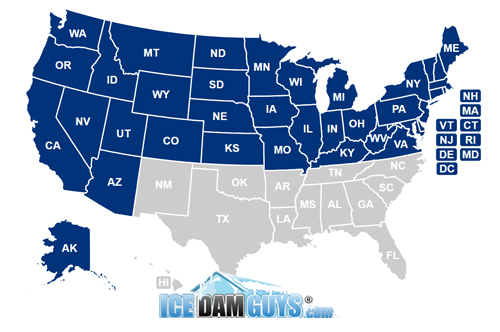The Pitfalls of DIY Ice Dam Removal
If you’re not prepared for it, ice dam removal can cause a bit of sticker shock. Some people who’ve called us tried to work around that by attempting do-it-yourself ice dam removal.
Your accident might make a hilarious YouTube video and make a star of the neighbor’s snotty kid, but if you value your home and the contents of your head, you’ll find a kinder and gentler DIY project.
There are only three ways to remove ice: by chemical reaction, heat, or blunt force.
Why blunt force is a terrible way to remove ice dams
Blunt force just isn’t good for the roof. Your shingles are brittle and vulnerable to all sorts of pressure in the winter. In fact, there are insurance companies out there who don’t recommend even walking on shingles at all in winter, because they’re so fragile. Of course, we have no choice but to walk on them, but when we do we’re very careful about it. I’m not saying you can’t send someone up to your roof. I’m just saying your shingles are fragile.
Now, picture those delicate little shingles with a Neanderthal do-it-yourselfer on top of them with a hammer, chisel, or axe. Let’s assume he never misses and never manages to hit a single shingle. (Not that that will happen.) Blunt force is still going to cause damage, because although you may get the ice off, you’ll take the granules with it. Granules help your shingles shed water. Got no granules? You’ve got nothing. You’ve essentially got hard paper up there instead of a covering that protects you from the elements.
That’s the best-case scenario. More likely is you’ll also miss a few times and break some shingles, and need to call a roofer. The insurance company probably won’t be interested in covering the damage, because you caused most or all of it yourself.
Why a chemical reaction is not much better
Do you like the grass around your driveway and sidewalks. Salt, the most common chemical used in DIY ice dam removal, kills it. That’s just the beginning of what salt – or any other chemical agent you may use in your attempts to remove ice dams – can do.
Read the fine-print. Nearly every label tells you to do a test area to see if there’s any reaction. You may cause the reaction on a test patch or on your entire roof, but there will almost certainly be one. What does the salt company care? You’ve already bought the product and they told you there “could” be a reaction. They covered their rears by telling you to try a small test area first.
Contractors who pour fancy concrete driveways tell you never, ever to salt them or use any type of ice-melt product on them. That’s why we get customers for driveway ice removal every year. People don’t want to damage their expensive driveways, too.
I would only use a chemical as a last resort. If you don’t care much what your roof looks like, or your ceiling is falling in, or you’re broke, or you can’t get any ice dam removal company on the phone because it’s prime leak season. Maybe take your chances then. Still, make sure you don’t care about the landscaping under your roof, because you’re about to give everything a big saltwater bath. There’s a good chance that your plantings underneath the overhang of your roof will end up the color of meatloaf.
DIY Heat?
Unless you own a steamer, as we do, there is just no way you’re going to use heat safely.
Once, I had a young lady call me in a panic. Her dad was up on her roof. He was drilling holes in the ice dam with a cordless drill, filling the holes with small amounts of gasoline, and lighting them on fire. She was frightened for him, and frightened for her house, which he was about to set on fire. Clearly she didn’t get her quick thinking from old pop.
We drove out there, and sure enough, there he was. Couldn’t believe it.
Gentle Reader, I know you have more sense than to use a flame on your roof.
Of course, some people try using hot water. They blast it through a hose. That’s not too effective, (but it least it won’t set your house or hair on fire). It might make your leak worse, though. You might use 300 gallons of water to remove the ice dam. As you head to the kitchen to reward yourself with a beer, you’ll step in 50 gallons of them.
If you own a steamer, and know how to use it? Go nuts. You can remove ice dams without ruining your house…but there’s one more caveat.
You may get hurt. You may even die.
Ice dam removal requires you to stand on a roof in the dead of winter. You’re up one, two, or three stories. The roof is slipperier than fish boogers. You’re climbing up and down a metal or fiberglass ladder with your snow-clogged boots. It’s hard, dangerous work, which is one reason that (good) ice dam removal services aren’t cheap.
Someone gets hurt in this industry every year. At least as often you’ll see the obituary of a homeowner who dies because he (it’s always an unwise guy) got up on the roof to remove snow or ice dams.
We have extensive training, the proper tools, the best safety equipment, and 20 years of experience in doing the job every day of every winter when people have ice dams. Do you want us to take care of your ice dam with a minimum of hassle, or would you rather we read about your attempt to do it?






















